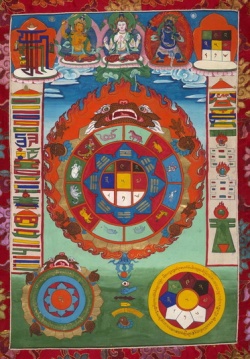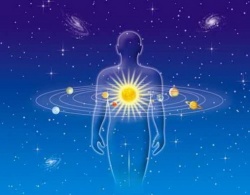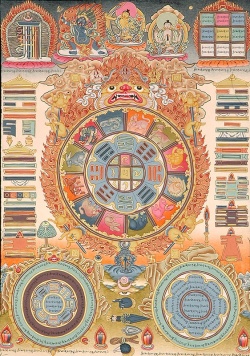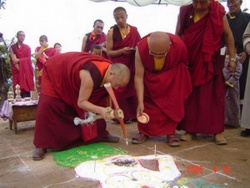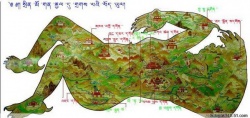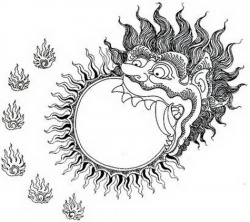Tibetan Geomancy II
"Ananda, what is this realm of time and space? Time means duration and space location.
You know that the ten directions are in space and that the past, present, and future are in time.
There are ten directions of space and three aspects of time.
All living beings owe their bodies to illusory time and space which are interwoven within them and continue to affect them."
Our initial essay on the loose topic of Tibetan geomancy -- extrapolative calculation more so than feng shui, even though "geomancy" is probably the wrong word -- discussed a method based on the relationship between trigrams.
We selected this method because it is commonly presented in the various English language books one finds.
It is also rather an old method for the Tibetans, dating back to the time of King Srong-btsang-sgam-po's Chinese wife, Kon-jo.
This is all introduced in the essay just mentioned, so you can refer back to set the stage.
Today, I thought it might be interesting to take our discussion to the next level, and introduce a few elements of information one never finds in the English language books.
We are going to examine the actual precedents of the Tibetan method.
The Tibetan method we presented in our first post is the simplified and culturally assimilated outgrowth of what was,
by the T'ang dynasty, a highly developed and almost bewilderingly complex feng shui methodology based on notice of landforms, stars, natural processes ("elements"), and points of the compass.
The trigrams were one symbolism invoked to manage this complexity. You can actually think of them as a language, if you like to think that way. To this point, some of you may recall I once wrote:
"Time and direction are the stagecraft of dreams.
The dreams are life, having all the indefinite properties of illusion, yet remaining sticky. We mark off these dreams of life with a linear past, present, and future.
We go to and fro, reaching out: pulling in.
We ought to enjoy the show but it is good not to believe too much.
What we really provide for ourselves by marking time and direction is a kind of fantastic parable of egocentricity; then invested with an idea of the duration of our egocentric selves in some sort of place or point.
"That is hardly immortal.
"We become controlled by our creations, our dreams of calendar, compass, and clock.
We become imprisoned in misery with hopes and fears for the future, trying to predict when we will get "out."
We look for all the reasons we stay "in," breeding other sets of hopes and fears for the present and the past.
"Why encourage this?
"When we first begin to seriously analyze time and direction they seem simple to know yet difficult to explain.
As we learn more, the language we are forced to use seems unconnected because we are dealing with unfamiliar concepts.
These concepts have an open, spacious, and even boring, featureless nature.
"Indeed, there are only slight precedents for the expression in any human language, concerned as language is with the task of communication by symbols rather than evocation by direct experience.
Among the possibilities we might want to consider is one which says that some divination systems could be nothing more or less than attempts to refine the languages of man, permitting more intimate experiences with time.
"They could be.
"They could also be the languages of the intimate experiences, celebrating themselves.
Be all that as it may, to reduce the complexity of T'ang era feng shui to a few basic concepts,
we can say that nine basic form factors were layered onto five courses theory (the "five elements"), and this was in turn layered onto twenty-four directions.
The twenty-four directions were layered onto twenty-four divisions of time, and the divisions of time were layered onto lunar mansions.
In this environment, the eight trigrams were the lingua franca, each one associated with (a) time, (b) direction, and (c) element.
Each trigram was made to manage three of the twenty-four divisions, and this subsumed the relationship of those three with the remaining twenty-one.
The whole of this approach was very much the product of what the T'ang geomancers called fen yeh: or the practice of drawing sky-earth concordances.
They imposed the night sky on China, and came up with four designated areas, or "palaces:" Dusky Warrior (north), White Tiger, (west) Red Bird (south), and Blue Dragon (east).
Each palace ruled seven lunar mansions.
This is the world that Queen Kon-jo knew.
When she left China, she was going to the realm of the White Tiger, to the land ruled by the Wolf Star, Sirius; land of the lunar mansion Mane, associated with war, executions, and death.
So, too, there is a notion that all of this is happening in an ordered progression.
The elements are producing and overcoming each other as the case may be, the earth is spinning, the directions are moving, and the stars are moving.
The notion of movement led to the rather romantically expressed concept of "wandering," "roaming," or "flying."
This was the idea that every year is ruled by a particular trigram; thus, the years are said to be moving.
This is a very simple idea, but it was not simply born.
The trigram ruling a year was proposed by the combination of symbols used to express the twenty-four divisions of time -- symbols known as "stems" and "branches."
Thereafter, to determine how this trigram would relate to the other trigrams -- in each of eight geomantic houses -- the practitioner would study how the lines of the trigram changed in order to become the trigram of the particular direction.
So, then, we now have a yearly trigram, and it is going to be the same as one of the trigrams ruling one of the eight geomantic houses.
By noting how the lines of the trigram change, we have some idea of the relationship of this trigram to the seven remaining houses.
I want to notice in passing that for years, people have decided they know precisely how this happens.
However, the entire belief system suffered a jolt when archaeologists dug up a trove of scrolls at Mawangdui, among which were heretofore unknown -- now the earliest known -- versions of the I Ching.
They discovered that arrangements of the lines had originally proceeded in a manner much different than anyone ever suspected.
This process became known two ways: as "lesser moving transformation" and "greater moving transformation;" the former used to examine sites for the dead, i.e. tombs, and the latter used to examine sites for the living.
Therefore, the Tibetan method we discussed in our initial article on the subject is properly known as the "greater moving transformation" method. Sometimes, this is simply called the "moving year" method.
At this point, we should understand that there are seven ways to change the component lines of any given yearly trigram in order that it may transform into the remaining trigrams.
In the T'ang, these seven moving lines were associated with seven stars of the Big Dipper.
Of course, they knew nine stars, but for the geomantic system they used seven.
The T'ang astrologers and geomancers referred to these stars by their variously specialized names (there are common, standard,
inner, outer, and secret names, in addition to other possibilities mentioned hereunder) and that is most certainly the way that Queen Kon-jo -- devout Buddhist or no -- would have referred to them.
You also must understand that in her time, these stars were not just lights in the sky; rather, they were invested with personalities, and various attributes. There was in fact an entire palette of possibilities.
If you were a mandarin, you had one palette.
If you were a woman, you had another palette. There are therefore many names, and the names are variously translated, but here are the main, external images:
Hungr Wolf
Giant Gates
Prosperous Existence
Lettered Composition
Incorruptible Virtue
Martial Composition
Defeated Army
Now, in China, east was considered yang, and west was considered yin. So, to arrange these images, the T'ang geomancers put the positive, or fortunate images in the east, and the negative, or unfortunate images in the west.
They put corruption in the north, and virtue in the south.
They divided the eight geomantic houses into two groups of four each:
This was sufficient for tombs, but it was not sufficient for the living.
In order to introduce further nuances, the geomancers also arranged the houses in terms of greater and lesser, so now you had a progression in each group of four:
from lucky to really lucky, and from bad to really bad.
They also completely reversed the east-west paradigm, saying that west was favorable and east was unfavorable.
They also made one other refinement, which was to introduce the image of "servants," which now gave them eight distinct images to symbolize each of the eight geomantic houses.
The "servants" image was simply the yearly trigram, and the trigram among the eight that was its duplicate.
Now the arrangement became as follows -- these are the T'ang "greater moving" inner names, and remember this is with reference to the Big Dipper:
Ursa Majoris Alpha: lucky -- birth
Ursa Majoris Beta: lucky -- sky healing
Ursa Majoris Gamma: unlucky -- harm
Ursa Majoris Delta: unlucky -- six killers
Ursa Majoris Epsilon: unlucky -- five ghosts
Ursa Majoris Zeta: lucky -- extended time
Ursa Majoris Eta: unlucky -- end of fate
Servants: lucky
If you glance back to our first article, you see how the Tibetan names come to resemble these images: "sky healing" and "five ghosts" are the most obvious correspondences, and you can work out the rest from there.
So, now you have learned something about Tibetan astrology that the Tibetan astrology books do not teach you, and you have learned something that most Tibetan astrologers do not know.
Now, we mentioned that Queen Kon-jo was a Buddhist, and indeed she was a fervently devout Buddhist, so it might do her some justice to examine the ways Buddhism could relate to the ideas of the T'ang astrologers, who after all were operating on the basis of a fundamentally Daoist cosmology.
We can begin by asking what sort of Buddhist cosmology would the Queen know?
Would she know Abidharma? It seems possible, but we find no evidence that Abidharma cosmology colored her geomantic methods.
Would she know Kalachakra cosmology?
Seems highly unlikely.
This leaves us with Dzogchen cosmology, and since we are looking at arts that are, by the T'ang, well grounded in Daoist thought, we might find something interesting along the lines of the old Daoist versus Dzogchen arguments.
After all, the Daoists and the Dzogchen practitioners both enjoy the number five.
You know, something "could" be there -- in theory if not in fact -- but it certainly does not leap out.
Dzogchen does not care to count how many stars are in the sky.
Dzogchen does not entertain directions.
There are referential features such as the five lights engendering the five elements, and so forth, but these features -- by their very nature as referential features -- dissipate.
There are in fact not five elements but twenty-five elements -- five earths, five waters, five fires, five winds, five spaces -- none of which are in opposition to each other, nor may they be said to produce or overcome each other.
They manifest as deception, so what are you pointing at? Everything lives in its own condition.
Any postulated concordances are superficial, no less than they are artificial -- like explaining a movie in order to explain "life." Remember that the next time somebody tries to sell you "pre-Buddhist, Dzogchen geomancy."
"If you realize the real to return to the source, the void in the ten directions will vanish."
It seems more likely than not that when Queen Kon-jo is performing her calculations, Buddhism doesn't enter into the matter very much all.
When she is transmitting the moving year method of geomancy, she is transmitting a classical Chinese system influenced by the Daoists.
All the Tibetans do is tune up the language, and follow the owner's manual.
Through the years, this becomes a rote exercise. Nobody remembers the fine points about roaming years, stars, moving lines, and so forth.
"Heretics always speak of natural existence but I preach causes and conditions which are beyond the stage they have reached."
--Surangama Sutra
What Dzogchen presents is a deeper, immediate abiding in what Buddha presents.
When, according to the Surangama Sutra, Buddha discussed time and direction he did so in terms of latency, or potential, or arising possibility.
He said, "The entanglement of the three times with the four cardinal points, or the four cardinal points with the three times, results in the constant twelve.
Allowing for the change and transformation of discriminative thoughts occurring thrice (to cover past, present, and future), this constant is increased..."
He explained this as an increase to cover the potential function of the six sense organs, each organ being represented by the number 1,200.
He gave the example of your eyes:
"Ananda, now measure the potentiality of each organ.
For instance, your eyes can see things in front and on both sides, but nothing behind you.
Its incomplete field of activity represents only two thirds of the maximum, that is only 800 merits."
After demonstrating the inconsistent potential of the other senses -- the ears amount to 1,200, the body 800, and so forth, Buddha concluded:
"Ananda, as you now wish to go against the samsaric current of desire, you should revert to the very organ (from which it flows) until you reach the state beyond birth and death.
You should look into the six functioning organs and see which one is consistent or not, is deep or shallow and is all-penetrating or deficient.
If you find the all-pervading organ, you should turn back its karmic flow so that it accords with its penetrating quality: the difference between realization by means of this penetrating organ and that through a deficient one is comparable to that between a day and an aeon.
I have now revealed to you the six organs (arising from) your True Mind and their respective potentialities so that you can choose the one most suitable to you and advance in your practice."
We make elaborations, and then we name these elaborations as a philosophy, or as "geomancy," or "feng shui."
They are cheaper than psychiatry, but what else can we really say about them?
Great proficiency in the mantic arts will not liberate you.
At best, great proficiency in the mantic arts is like learning another language: one that might allow you to help others, should you go to the place where that language is spoken.
Therefore, what I want to say about Tibetan geomancy is at this point maybe a bit disappointing.
Talk of tortoises arises in questions of "yes" or "no."
We can ask once, or we can ask several times.
Depending on possibility no less than probability, we can arrive at any number of answers one way or the other.
By adding to the number of times we ask, we alter the possibilities.
By adding to the fundamental of "yes" or "no," we alter the probabilities rather considerably.
Maybe the tortoise is anxious, and he is sweating. Maybe he is steaming.
In the final analysis, the only thing there is what we put there.
Go where you want to go, do what you want to do.
Hand the tortoise a towel. </poem>
